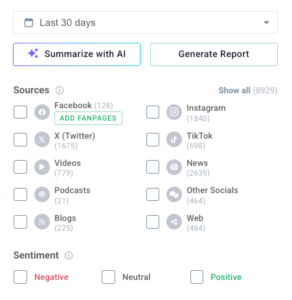Having a social media presence offers a rich array of opportunities to many businesses. But, creating a social media strategy is often underpinned by measuring “vanity” metrics, such as likes and shares. After all, it feels good to know your content is liked and shareable.
However, to get deeper meaning out of your social media strategy, marketers need to look beyond these metrics. This is where advanced analytics for social media take center stage.
In this article, we offer a deeper understanding of social media analytics, share advanced analytics techniques, and provide several best practices worth following. Let’s take a closer look.
Understanding Social Media Analytics
Having a firm grasp of social media analytics is essential for marketers. Below, we offer a few insights into understanding them better and why it is so essential.
Definition and scope of social media analytics
Social media analytics are both quantitative and qualitative measurements of your users’ interaction with your content as part of your social media marketing strategy.
On the quantitative side, you could consider numbers and figures or the tangible results of a social media marketing campaign or strategy. Possible examples may include aspects such as the total budget for a campaign, total sales, the number of new customers onboarded or acquired, various types of engagement, etc.
On the qualitative side, you can explore aspects such as customer sentiment, customer satisfaction, net promoter score (which signals how likely a customer is likely to recommend your product or service), customer response rates and times, and more.
Often, quantitative and qualitative metrics are used in conjunction with each other to provide a solid picture that helps marketers better understand and gain deeper meaning from their social media data.
Key metrics and KPIs in social media analytics

To date, many marketers have focused on measuring limited social media metrics only, ranging from likes and shares. While these can be useful to an extent, they don’t and cannot offer a holistic picture of your return on investment (ROI) within the context of a certain social media campaign or strategy. A list of some important metrics currently measured appears below:
- Engagement rate
- Reach
- Impressions
- Conversion rate
- Cost per click
- Share of voice
- Video views
- Brand mentions
- Website traffic
- Bounce rate
- Comments
- Customer satisfaction score
- Follower count and growth rate
- Return on investment
- Hashtag performance
- Post clicks
Importance of social media analytics in business decisions
Businesses know that the more data they have available, the better business decisions they can make. The same is true for social media data. However, apart from merely making sound business decisions, measuring the right metrics and using the right social media analytics tools and techniques has several other important benefits. These include:
- Better targeting and segmentation
- More effective strategizing
- Higher sales
- More website traffic
- Better customer service
- Increased customer loyalty
- Improved features of products or services
- Stronger social listening
- Improved revision of strategies, tactics, and offerings based on customer feedback
- Stronger ROI and better allocation of resources
- Emphasis on strategies that work and eliminating those that yield poor results
And a whole lot more
Furthermore, effective customer retention strategies, informed by deep analytics, can lead to increased repeat business and a more sustainable growth model, as they allow businesses to engage with and understand the needs of existing customers continuously.
Advanced Analytics Techniques for Social Media
And now we come to the crux of social media analytics by sharing a few of the advanced techniques that you should be using to gain more out of your next social media campaign. From predictive analytics to audience segmentation and targeting, the list below will help you strategize that much more effectively.
Predictive analytics
Using predictive analytics is essential for understanding how your social media strategy is expected to perform in the future. As mentioned earlier, you can use both quantitative and qualitative data to predict user behavior based on past performance.
On the quantitative side, you can use tools such as Google Analytics, Facebook Insights, or Twitter Analytics to track metrics and gather your data. On the qualitative side, you can use surveys, interviews, or focus groups. The ultimate aim is to identify patterns, trends, and insights that help you understand both your performance and your audience’s behaviors, preferences, and needs.
Once the data collection step is over, you should build predictive models to help you forecast future outcomes. For this purpose, you can use techniques including regression analysis, classification, clustering, time series analysis, etc. Once the model is built and the data entered into it, it’s time to evaluate the results.
Use insights to determine what type of content to create, when to post, who to target, how to allocate your budget, and more. Finally, it’s essential to ensure you compare your performance against predetermined key performance indicators (KPIs) to know if you are on the right track.
Sentiment analysis

Sentiment analysis looks at factors that are often unquantifiable such as:
- The likelihood of a customer recommending your product or service
- Measuring whether a customer feels positive, negative, or neutral about your business
- Determining if the speed of your social media customer service is good enough and whether it is sufficiently effective
Sentiment analysis uses words to measure the emotions, tone, and intent associated with your business. This can enable you to make informed decisions about how to proceed and tailor your social media strategy accordingly.
Influencer analysis
If you work with one or several influencers who regularly post about your product or service on social media, you’ll want to measure their performance, too. To do so, you need to have data that relates to their ability to target certain demographics and drive engagement rates, reach, impressions, and conversions.
Content performance analysis
As you create and publish content that you share on social media, it’s definitely worth it to consider how your content is performing.
Aspects that you could measure include:
- Traffic to your web pages, campaign landing pages, and blogs
- The number of videos viewed and interacted with
- The number of views and downloads of your infographics
- The performance of your marketing emails as part of your broader social media strategy
Once you have identified which content type works best for your particular campaign and audience, you can follow the rinse and repeat strategy.
However, if you’re finding that your social media marketing metrics are underperforming, it’s time to consider making some adjustments to ensure your KPIs and goals are met.
Audience segmentation and targeting
Finally, you may be tempted to cast a wide net on your social media channels but with such a strategy, you’re less likely to achieve your goals. To avoid this issue, start by identifying your ideal buyer persona.
Determine their demographics and segment them into two or three personas that you can market to. Once you’ve identified your ideal buyers, make sure to segment them in terms of demographic criteria such as region and location, age, gender, marital status, income, and other criteria.
The more targeted your campaign, the smaller your audience size will be. However, with this strategy, your ROI is likely to be higher and your targeting and segmentation will be more effective.
Best Practices for Advanced Social Media Analytics
As we wrap up, we’d also like to share a few of the best practices for your advanced social media analytics efforts. Here’s what’s worth considering:
- Setting goals and objectives: The saying “what gets measured gets managed” has never been more important than right now. You need to set SMART goals that will help you determine if your social media strategy is effective.
- Selecting relevant metrics and KPIs: Once your goals are in place, break them down into measurable metrics and KPIs. However, don’t just focus on the quantitative data. Be sure to incorporate qualitative metrics, too.
- Data collection and validation: Your goals and metrics are all set. It’s time to put your strategy into action. Give yourself a certain amount of time and then start measuring your performance by collecting data from all your social media channels.
- Data visualization and reporting: With the data having been collected, it’s time to make it work for you. Whether you use spreadsheets, pie charts, bar graphs, or any other method, create a compelling picture of your data that shows the results of your efforts and gather insights on where and how to improve your performance.
- Continuous monitoring and optimization: This process is a never-ending one and you will want to engage in continuous monitoring, optimization, tweaking, and refinement so that you are always getting the best results and the most out of your social media channels.
Conclusion
The rich and diverse world of social media offers businesses the chance to break through to their target audience at the right time with the right type of content. It requires a highly strategic and forward-thinking approach that utilizes advanced social media analytics, including both quantitative and qualitative data. Use the tips mentioned above to help you and enjoy the results of a winning social media strategy that delivers time after time.



